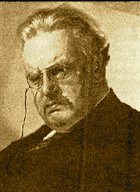When the church goes to the dogs
The first challenge to my naive dream for the Church began when, as a new believer, I attended my first church members' meeting. I left disillusioned after a night of heated debate over where the choir should stand during Sunday services.
G. K. Chesterton once reflected that, "On five occasions in history the Church has gone to the dogs, but on each occasion, it was the dogs that died." If Chesterton were alive today I have no doubt he would be writing about the sixth occasion. In this generation will it be the dogs that die? Will the Church be transformed to overcome the challenges we face? Leonard Sweet observes that, in the postmodern world the old maps are obsolete. We're going to have to construct new ones as we go. Although the terrain is unexplored, we are not without a compass. Others have faced this challenge.
Jacques Ellul described the whole history of the Church as the history of the reformation of the Church by the Spirit. Paul Pierson contends that in the renewal and expansion of the Church, the breakthroughs always occur on the fringe of ecclesiastical power"”never at the centre. In every generation, in some obscure place, God is beginning something new that will one day impact the centre.
That something new can invariably be described as a "movement". By "movement" I am referring to any group of people called by God who are dedicated to pursue individual and corporate transformation; resulting in the renewal and expansion of the Church in its mission. Throughout church history there has been an incredible diversity of renewal movements, each making their unique contribution. The most effective share five common characteristics.
A sixteen year-old boy is taken captive by raiders and sold into slavery. Desperate with loneliness, hunger and cold he cries out to God for deliverance and is answered. He goes on to pioneer one of the greatest missionary movements the world has ever seen.
An obscure Augustinian monk agonizes over what it means to be made right with God through faith. His is an intensely personal struggle out of which the Protestant Reformation is born.
A young minister returns from the mission field, a failure in his own eyes, devoid of the experience of God's loving acceptance. His heart is "strangely warmed" by the grace of God and one of the most significant awakenings in modern history shakes Britain and spreads world-wide.
Patrick of Ireland, Martin Luther and John Wesley—we remember them as powerful historical figures through whom God renewed the Church and transformed the world. We honour them as heroes of the faith. We forget they began as broken men crying out to God for an encounter that would change their lives. Out of personal encounter with God, these transformational leaders went on to renew the Church and to shape the world in which we live.
We all seek to avoid the tension created by the gap between our ideals and our reality. Effective movements exploit that gap and raise the tension. They make life uncomfortable for us all. Movements are uncompromising. They heighten tension inside the Church and with the surrounding culture. Movements are born in conflict, because they stand for something.
Australians are cynical when it comes to religion. But in Australia the Salvation Army has a 98% approval rating. That's pretty good considering God polls at only 72%! It has taken generations to build that respect. How did the Salvation Army begin as a renewal movement? They began with the same Church and societal opposition that the early Methodists and Pentecostals faced. They were mocked in the Press, they were beaten by gangs, their meetings were disrupted, their buildings burnt down.
Passionate people make history. That's true for both social and religious movements. They take their cause seriously. They have a clear message that is communicated unambiguously and lived out consistently. The result is often dramatic growth.
Changed lives are at the heart of every rapidly spreading religious movement. Lives are impacted, friends and family are influenced. New converts become doors through which the Gospel enters into previously unreached social networks. Sociologically, "Conversion is adopting the faith of your friends."
A key to the incredible growth of Pentecostalism in the 20th Century has been its tendency to grow via face-to-face recruitment by committed individuals using their own pre-existing, significant social relationships. Today, the impact of the Alpha program around the world is attributable to that same dynamic—the spread of the Gospel, from life to life.
A simple, supernatural message of salvation; lives are transformed; and the Gospel spreads like wildfire throughout networks of relationships. The cycle begins again as new converts are quickly deployed in ministry.
George Bernard Shaw observed that, "Every profession is a conspiracy against the laity." It's not that movements abolish the clergy. Rather they abolish the laity. Everyone is ordained and mobilized for ministry.
In 1776 just 17% of the Americans were affiliated with a church. By 1850 that number had grown to 34%. The change can be attributed to dramatic success the "upstart" Baptists and Methodists had in reaching unchurched people on the frontier. The Baptists and Methodists were led by poorly educated, poorly paid "amateurs" who closely resembled the people they served. In contrast, the sophisticated clergy of the established churches were not trained to earn their own livings behind horse and plow, nor were they prepared to spend half their days in the saddle going from one rural hamlet to another.
The Baptists and Methodists planted churches where the people were and empowered them to take responsibility for the ministry. A rapidly changing environment demanded that new models for leadership development be implemented. The rest is history.
Unencumbered by tradition, movements feel free to experiment with new forms of the church and new effective methods of ministry.
Religious organizations are notoriously difficult to change. Over time our methodologies become even more sacred than our message. In contrast, dynamic movements are characterized by "sanctified pragmatism." They are conservative in doctrine but radical in methodology. When John Wesley first encountered field preaching as a means of mass communication, he was offended. Yet, as he was increasingly shut out of the churches of the day he became an ardent practitioner. "I love the rites and ceremonies of the Church. But I see, well-pleased, that our great Lord can work without them."
Movements adapt themselves to the world around them. They pioneer new and effective strategies without compromising their message.
Conclusion
All around us we see the evidence that the Church as a human institution is in continual decline and decay. Today, much of the Church is still grappling with what mission looks like in the modern world and has no idea of the deep social changes that are being ushered in by the emergence of postmodernity. History offers no guarantees that the Church in its current form will survive.
The uncomfortable reality is that, "It belongs to the very life of the people of God that it must accept again and again to have its life renewed by a new confrontation with its Lord and his holy will." The Church is the body of Christ, the temple of the living God who renews His people by His Spirit. This experience of death and new life will continue in the Church until the day when there is a new heaven and a new earth and the Holy City, the new Jerusalem, will come down out of heaven from God, prepared as a bride beautifully dressed for her husband.
Until that day, let's dream together of what the Church can become and refuse to put our money on the dogs.

